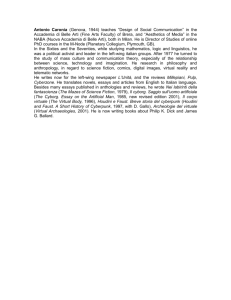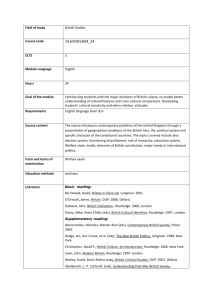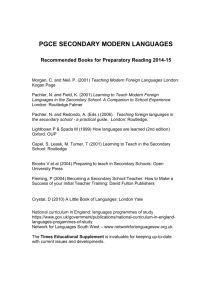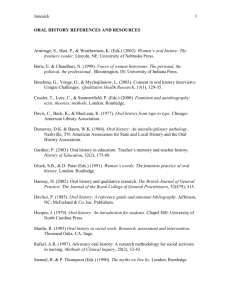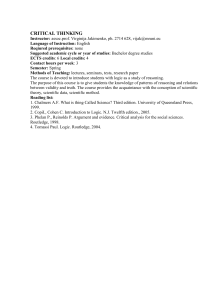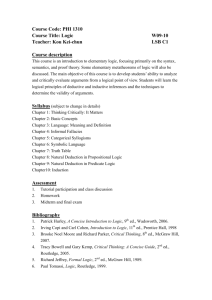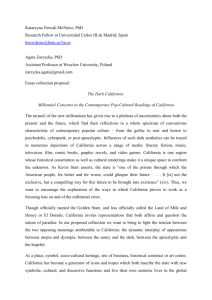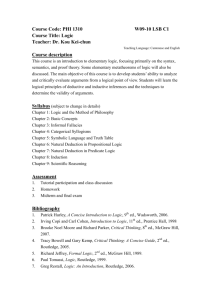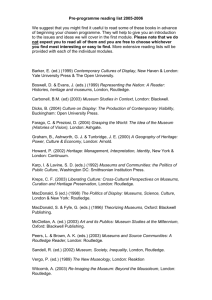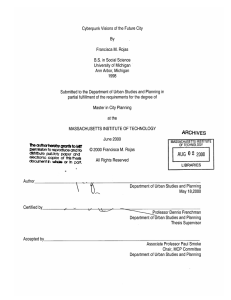Complexity Theory - The Chinese University of Hong Kong
advertisement
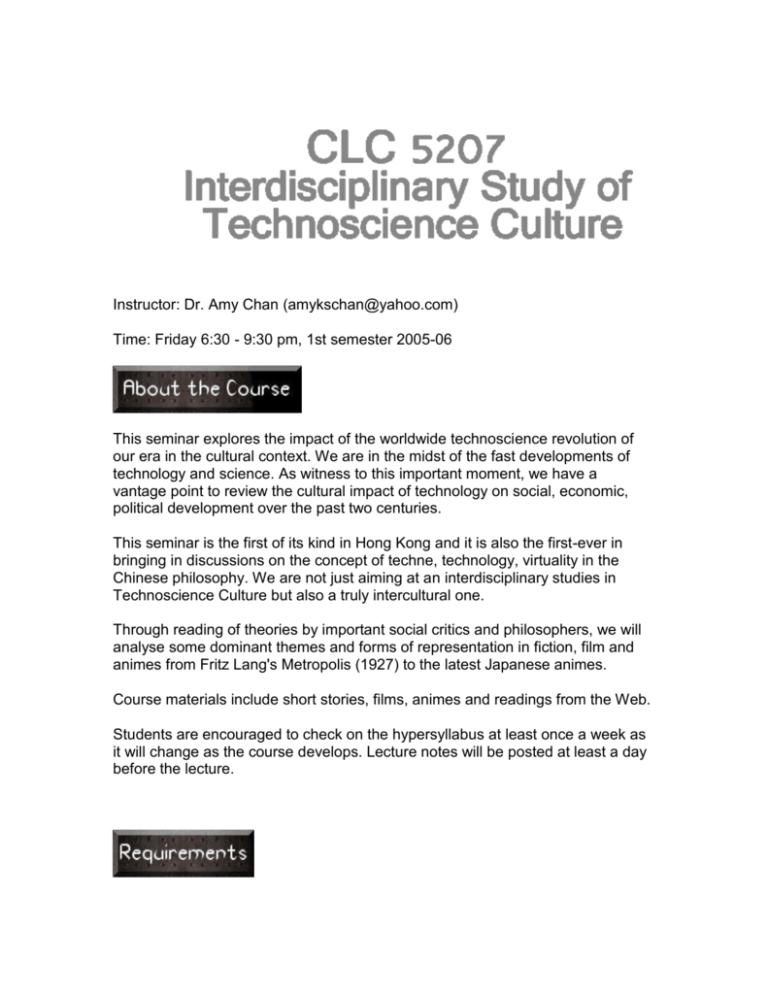
Instructor: Dr. Amy Chan (amykschan@yahoo.com) Time: Friday 6:30 - 9:30 pm, 1st semester 2005-06 This seminar explores the impact of the worldwide technoscience revolution of our era in the cultural context. We are in the midst of the fast developments of technology and science. As witness to this important moment, we have a vantage point to review the cultural impact of technology on social, economic, political development over the past two centuries. This seminar is the first of its kind in Hong Kong and it is also the first-ever in bringing in discussions on the concept of techne, technology, virtuality in the Chinese philosophy. We are not just aiming at an interdisciplinary studies in Technoscience Culture but also a truly intercultural one. Through reading of theories by important social critics and philosophers, we will analyse some dominant themes and forms of representation in fiction, film and animes from Fritz Lang's Metropolis (1927) to the latest Japanese animes. Course materials include short stories, films, animes and readings from the Web. Students are encouraged to check on the hypersyllabus at least once a week as it will change as the course develops. Lecture notes will be posted at least a day before the lecture. This course does not require students to have computer skills or knowledge. Presentations. Students are required to give a 30- minute presentation on a specific topic. Should the student fail to deliver the presentation on the pre-assigned week, a written report on the topic (about 2000 words) should be submitted within two weeks. 30% of final grade. Final Project. Students are required to write a research essay for a final, individual project. The length of the text should be 12-14 A4 doublespaced typed pages. Students are encouraged to include multimedia content, according to one's ability and interests, in this final project. Submission of this project could be made in electronic form. The project has to be submitted on or before 5 December 2005. 70% of final grade. Notes on Films and Readings. Students must view the required films and go through the readings BEFORE each class. Students are required to provide their own reading materials due to copyright problems. Course Textbook: David Bell's Introduction to Cybercultures Course Reference book: David Bell's The Cybercultures Reader and Cyberculture: Key Concepts Week 1 Topics Films Course Introduction 9/9 2 16/9 3 23/9 Cyberculture/ Technoculture & (Inter)cultural Studies Cyberspace and Virtual Reality Lang, Metropolis Branagh, Mary Shelley's Frankenstein Wachowski, The Matrix Trilogy 4 Post-Information Age Levinson, Wag the Dog Weir, The Truman Show 30/9 Niccol, S1mOne 5 Cyberpunk Tradition Scott, Blade Runner 7/10 Proyas, Dark City 6 Cyberpunk and Postmodernity Cronenberg, eXistenZ 14/10 Rusnak, The Thirteenth Floor 7 Posthumanism Niccol, Gattaca 21/10 Spielberg, Artificial Intelligence: A.I. 8 Posthuman and Cyberbodies Cameron, Terminator 2: Judgment Day 28/10 Verhoeven, Robocop 9 Cyberfeminism I Oshii, Ghost in the Shell Ghost in the Shell II: Innocence Cyberfeminism II Oshii, Avalon Video Game Culture Badham, WarGames Lisberger, Tron 4/11 10 11/11 11 18/11 12 Complexity Theory 25/11 Speilberg, Jurassic Park & Aronofsky, Pi Hypertext Bress, The Butterfly Effect 13 Technoculture in the Chinese Context Rin, Metropolis Chung, Animatrix 2/12 & Proyas, I, Robot Conclusion Reading Materials Film Web Readings Week 1 Introduction to the Course: Receptions and Interpretations of Technology in the Postmodern Age Introduction to Cybercultures, Chapters 2 & 3 Menser, Michael & Aronowitz, Stanley. (1996)“On Cultural Studies, Science, and Technology”. Technoscience and Cyberculture. Ed. Stanley Aronowitz et al. New York and London: Routledge. pp.7-30 Poster, Mark. (1996)“Postmodern Virtualities.” FutureNatural: Nature, science, culture. Ed. George Robertson et al. London and New York: Routledge. pp.23-42. Reference: Feenberg, Andrew. (1999)“Critical Theories of Technology.” Questioning Technology. London and New York: Routldege. Baudrillard, Jean. (1998) "Simulacra and Simulation”. Jean Baudrillard: Selected Writing. Ed. Mark Poster. Cambridge: Polity Press. Week 2 Cyberculture/Technoculture & (Inter)cultural Studies Introduction to Cyberculture, Chapter 4 Best, Steven & Kellner, Douglas. (2001) "Technological Revolution and Human Evolution." The Postmodern Adventure: Science, Technology and Cultural Studies at the Third Millennium. 149-204. Reference: Slusser, George. (1992) "The Frankenstein Barrier." in Fiction 2000: Cyberpunk and the future of Narrative. Eds. George Slusser and Tom Shippey. Athens: University of Georgia Press. pp.46-74. Week 3 Cyberspace and Virtual Reality Introduction to Cybercultures, Chapters 5-6. Graham, Gordon.(1999) "Virtual Reality: The future of cyberspace". the internet://a philosophical inquiry. London and New York: Routledge. Turkle, Sherry. (2002) "Constructions and Reconsturctins of the Self in Virtual Reality." Cyber_Reader: Critical writings for the Digital Era. Ed. Neil Spitler. London: Phaidon. 208-215. Reference: Heim. Michael. "Essence of VR" CyberReader. Ed. Victor J. Vitanza. Boston: Allyn and Bacon, 1999. pp.20-35. Benedikt, Michael. (2000)"Cyberspace: First Steps." Cybercultures Reader. Ed. David Bell. London: Routledge. pp. 29-44. Bromberg, Heather. "Are MUDs Communities? Identity, Belonging and Consciousness in Virtual Worlds." Cultures of Internet, Virtual Spaces, Real Histories, Living Bodies. Ed. Rob Shields. London: Sage, 1996. pp.143-152. 紀大衛 ”去年在馬倫巴:模擬網頁小說”中外文學.1997 年 8 月 303 期 pp.102-119. Philip K. Dick, "We Can Remember It For You Wholesale" (This short story was adapted into Total Recall) Week 4 Post-Information Age Kellner, Douglas. (1995) "Mapping the present from the future: from Baudrillard to Cyberpunk”. Media Culture: Cultural studies, identity and politics between the modern and the postmodern. London and New York: Routledge. Baudrillard, Jean. The Ecstasy of Communication. Baudrillard, Jean. (1995) the gulf war did not take place. Bloomington & Indianapolis: Indiana University Press. Reference: 張大春 , 大都會的西米 Winkler, The Net Week 5 Cyberpunk Tradition Introduction to Cybercultures, Chapter 6 Cavallaro, Dani. (2000) "Cyberpunk, Technology and Mythology" Cyberpunk and Cyberculture: Science Fiction and the Work of William Gibson. London: The Athlone Press. pp.41-71. Leary, Timothy. (2000) "The Cyberpunk: The Individual as Reality Pilot." Cybercultures Reader. Ed. David Bell. London: Routledge. pp.529-539. Reference: Sterling, Bruce. (1988)"Preface." Mirrorshades: The Cyberpunk Anthology. Ed. Bruce Sterling. New York: Ace Books. Spottiswoode, The 6th Day Greg Egan, "The Extra" Week 6 Cyberpunk and Postmodernity McHale, Brian.(1991) "POSTcyberMODERNpunkISM." Storming the Reality Studio: a Casebook of cyberpunk and Postmodern Fiction. Ed. Larry McCaffery. Durham and London: Duke University Press. pp.308-323. Hollinger, Veronica. (1991)"Cybernetic Deconstructions: Cyberpunk and Postmodernism. Storming the Reality Studio: a Casebook of cyberpunk and Postmodern Fiction. Ed. Larry McCaffery. Durham and London: Duke University Press. pp.203-218. Reference: Gibson, William. "Johnny Mnemonic." 村上春樹, 世界末日與冷酷異境 Longo, Johnny Mnemonic Week 7 Posthumanism Gray, Chris Hables. (2001) "The Cyborg Body Politic." Cyborg Citizen: Politics in the Posthuman Age. New York & London: Routledge. pp.9-20. Hayles, N. Katherine. (1999) Excerpts from How We Became Posthuman Virtual Bodies in Cybernetics, Literature, and Informatics. New York: University of Chicago Press. Fukuyama, Francis. (2002) “Genetic Engineering.” Our Posthuman Future: Consequences of the Biotechnology Revolution. London: Profile Books. pp.72-83. Reference: Lesitt, Shariann. (2002) "A Real Girl." Reload: Rethinking Women + Cyberculture. Eds. Mary Flanagan and Austin Booth. Cambridge: The MIT Press. 505-518. Stelarc. (2002). “Towards the Post-Human.” Cyber-Reader: Critical Writings for the Digital Era. Ed. Neil Spiller. London: Phaidon. pp. 262-269. Week 8 Posthuman and Cyberbodies Introduction to Cybercultures, Chapter 7 Tomas, David. (1995) "Feedback and Cybernetics: reimaging the Body in the Age of Cybernetics.” Cyberspace, Cyberbodies, Cyberpunk: Cultures of Technological Embodiment. Eds. Mike Featherstone and Roger Burrows. London: Sage, 1995. pp.21-44. Murphie, Andres and Potts, John. (2002) "Cyborgs: the Body, Information and Technology". Culture & Technology. New York: Palgrave. 115-141. Reference: Greg Egan, "Learning to be Me" 平路, 按鍵的手 人工智慧紀事 Argyle, Katie & Shields, Rob. (1996) "Is There a Body in the Net?" Cultures of Internet: Virtual Spaces, Real Histories, Living Bodies. Ed. Rob Shields. London: Sage. 58-69. Gray, Chris Hables (2001) "Infomedicine and the New Body" and "Cybernetic Human Reproduction" . Cyborg Citizen: Politics in the Posthuman Age. New York and London: Routledge. 69-98. Balsamo, Anne. (2000) "The Virtual Body in Cyberspace." The Cybercultures Reader. pp.489-503. Hayles, N. Katherine.(1996) "The Life Cycle of Cyborgs". The Cyborg Handbook. pp.321-340. Cyborg History McAdams, Mindy. Gender Without Bodies. (Have you first try on hypertext) Hayles, N. Katherine. Excerpts from How We Became Posthuman Virtual Bodies in Cybernetics, Literature, and Informatics. New York: University of Chicago Press, 1999. Smith, Sean Aylward, "Where Does the Body End? " Schaffner, The Boys from Brazil Week 9 Cyberfeminism I Plant, Sadie. (1995)“The Future Looms: Weaving Women and Cybernetics”. Cyberspace, Cyberbodies, Cyberpunk: Cultures of Technological Embodiment. Ed. Mike Featherstone and Roger Burrows. London: Sage. Plant, Sadie. (2000) "On the Matrix: Cyberfeminist Simulations." The Cybercultures Reader. Ed. David Bell. London: Routledge. Pursell, Carroll. (2001) "Feminism and the Rethinking of the History of Technology." Feminism in Twentieth-Century Science Technology and Medicine. Eds. Angela N.H. Creager et al. Chicago and London: The University of Chicago Press. 113-127. Reference: Squires, Judith. (2000) "Fabulous Feminist Futures and the Lure of Cyberculture." The Cybercultures Reader. pp.360-373. Wosk, Julie. (2001) "Framing Images of Women and Machines." Women and the Machine: Representations from the Spinning Wheel to the Electronic Age. Baltimore and London: The Johns Hopkins University Press. pp.1-44. Hawthorne, Susan. "Connectivity: Cultural Practice of the Powerful or Subversion from the Margins?" Cyberfeminism: Connectivity, Critique+Creativity. Ed. Susan Hawthorne and Renate Klein. North Melbourne: Spinifex, 1999. pp. 119-136. Braidotti, Rosi. “Cyberfeminism with a Difference” Faith Wilding. "Where is Feminism in Cyberfeminism?" "Cyberfeminism as New Theory" Week 10 Cyberfeminism II Haraway, Donna. (1991)“A Cyborg Manifesto: Science, Technology, and Socialist-Feminism in the Late Twentieth Century.” Simians, Cyborgs, and Women: The Reinvention of Nature. London: Routledge. Deery, June. (2000) "The Biopolitics of Cyberspace: Piercy Hacks Gibson." Future Females, The Next Generation: New Voices and Velocities in Feminist Science Fiction Criticism. Ed. Marleen S. Barr. New York: Rowman & Littlefield. pp.87-108. Sandoval, Chela. (2000) "New Sciences: Cyborg Feminism and the Methodology of the Oppressed." The Cybercultures Reader. pp.374-390. Reference: Graham J. Murphy, "Pernicious Couplings and Living in the Splice." A What is Cyberfeminism? Russian Cyberfeminisms Week 11 Video Game Culture Lahti, Martti. (2003). “As We Become Machines: Corporealized Pleasures in Video Games.” The Video Game Theory Reader. Eds. Mark J.P. Wolf & Bernard Perron. London & New York: Routledge. pp. 157-170. Frasca, Gonzalo. (2003). “Simulation versus Narrative: Introduction to Ludology.” The Video Game Theory Reader. pp. 221-236. Reference: 朱耀偉、陳潔詩著.(2005) 窗. Week 12 《虛擬後樂園:透視電腦遊戲文化》.香港:天 Complexity Theory & Hypertext Hayles, Katherine N. “Introduction: Complex Dynamics in Literature and Science.” Chaos and Order: Complex Dynamics in Literature and Science. Ed. N. Katherine Hayles. Chicago and London: The University of Chicago Press, 1991. Plant, Sadie. (1996) "The Virtual Complexity of Culture." FutureNatural: Nature, Science, Culture. Ed. George Robertson et al. pp.203-217. Aarseth, Espen J. (1994) "Nonlinearity and Literary Theory." in Hyper/ Text/ Theory. Ed. George P. Landow. London: The Johns Hopkins University Press. Landow, George P. (1992) "The Politics of Hypertext: Who Controls the Text?" Hypertext: The Convergence of Contemporary Critical Theory and Technology. Baltimore and London: The Johns Hopkins University Press,. Reference: Hayles, Katherine N. "Introduction" The Cosmic Web: Scientific Field Models and Literary Strategies in the Twentieth Century. London: Cornell University Press, 1984. pp.15-30. Borges (1964) "The Circular Ruins." Labyrinths. New York: New Directions. Borges (1964) "The Library of Babel." Labyrinths. Exploring Fractals Sprott's Fractal Gallery Fractal Artwork Exhibits Joyce, Michael. "Notes Toward an Unwritten Non-linear Electronic Text, 'The Ends of Print Culture' (a work in progress)'" McGann, The Rationale of Hypertext. Joyce, Michael & Guyer, Carolyn. Lasting Image. (Read a hypertext in the web.) Cyberspace, Hypertext and Critical Theory Week 13 Technoculture in the Chinese Context This lecture will be a very brief introduction to the concept of technology, technique, techne in the ancient Chinese texts. Readings will be selected from Lao Zi, Zhuang Zi, Huainan Zi, The Yellow Emperor's Medical Canon, etc. Reference Introduction Aronowitz, Stanley et al, eds. (1996) Technoscience and Cyberculture. New York and London: Routledge. Bell, David & Kennedy, Barbara M., eds. (2000) The Cybercultures Reader. London & New York: Routledge. Feenberg, Andrew.(1999). Questioning Technology. London and New York: Routldege. Gray, Chris Hables, ed. (1995). The Cyborg Handbook. New York & London: Routledge. Murphie, Andrew & Potts, John. (2003). Culture & Technology. Hampshire: Palgrave. Schuler, Douglas et al, eds. (2003) Cyberculture: The Key Concepts. London & New York: Routledge. Spiller, Neil, ed. (2002) Cyber_Reader: Critical Writings for the Digital Era. New York: Phaidon. Media Kellner, Douglas. (1995). Media Culture: Cultural studies, identity and politics between the modern and the postmodern. London and New York: Routledge. Poster, Mark. (1995). The Second Media Age. Cambridge: Polity. Internet Shields, Rob, ed. (1996). Cultures of Internet: Virtual Spaces, Real Histories, Living Bodies. London: Sage. Jones, Steven G., ed. (1997). Virtual Culture: Identity and Communication in Cybersociety. London: sage, 1997. Thomas, Douglas. (2002) Hacker Culture. Minneapolis: University of Minnesota Press. Body Bukatman, Scott. (1993) Terminal Identity: The Virtual Subject in Postmodern Science Fiction. Durham & London: Duke University Press. Dyens, Ollivier. (2001) Metal and Flesh: The Evolution of Man: Technology Takes Over. Trans. Evan J. Bibbee and Ollivier Dyens. Cambridge & London: The MIT Press. Featherstone, Mike & Burrows, Roger, eds. (1995) Cyberspace, Cyberbodies, Cyberpunk: cultures of Technological Embodiment. London: Sage. Hayles, N. Katherine. (1999) How We Became Posthuman Virtual Bodies in Cybernetics, Literature, and Informatics. New York: University of Chicago Press, 1999. Ihde, Don. (2002). Bodies in Technology. Minneapolis: University of Minnesota Press. Terry, Jennifer & Calvert, Melodie, eds. (1997) Processes Lives: Gender and Technology in Everyday Life. London and New York: Routledge. CyberFeminism Balsamo, Anne. (1996) Technologies of the Gendered Body: Reading Cyborg Women. Ed. Anne Balsamo. Durham and London: duke University Press. Hawthorne, Susan & Klein, Renate, eds. (1999) CyberFeminism: Connectivity, Critique+Creativity. North Melbourne: Spinifex Press. Hopkins, Patrick D, ed. (1998). Sex/Machine: Readings in Culture, Gender, and Technology. Bloomington & Indianapolis: Indiana University Press. Kember, Sarah. (2003). Cyberfeminism and Artificial Life. London & New York: Routledge. Kirkup, Gill et al, eds. (2000) The Gendered Cyborg: A Reader. London & New York: Routledge. Wajcman, Judy. (2004) TechnoFeminism. Cambridge: Polity Press. Complexity Theory Cilliers, Paul. (1998) Complexity & Postmodernism: Understanding Complex Systems. London & New York: Routledge. Hayles, Katherine N., ed. (1991). Chaos and Order: Complex Dynamics in Literature and Science. Chicago and London: The University of Chicago Press. Robertson, George, et al., eds. (1996). FutureNatural: Nature, Science, Culture. London and New York: Routledge. Hypertext Reproduction Purdy, Laura M. “What Can Progress in Reproductive Technology Mean for Women?” Reproducing Persons: Issues in Feminist Bioethics. New York: Cornell University Press, 1996. Mitchell, Lisa M. & Georges, Eugenia. “Baby’s First Picture: The Cyborg Fetus of Ultrasound Imaging.” Cyborg Babies: From Techno-Sex to Techno-Tots. Ed. Robbie Davis-Floyd and Joseph Dumit. New York and London: Routledge, 1998. Ashford, Janet Issacs. “Natural Love.” Cyborg Babies: From Techno-Sex to Techno-Tots. Ed. Robbie Davis-Floyd and Joseph Dumit. New York and London: Routledge, 1998. Cyberpunk Cyberpunk Information Database http://project.cyberpunk.ru/idb/ Bethke, Bruce. “Cyberpunk”. (This is the short story in which the word “cyberpunk” first appeared.) http://www.cyberpunkproject.org/lib/cyberpunk/
